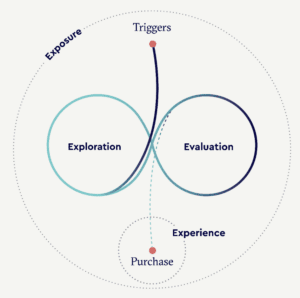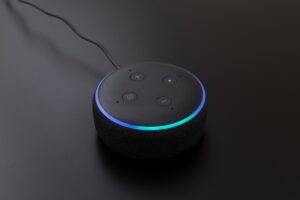
What to consider for a cross-device PPC campaign

A cross-device PPC campaign is becoming the future with the increasing use of mobile devices- it’s no longer just about desktop. More and more users are making purchases via their mobile phones due to its accessibility and ease. It’s important now more than ever to optimise your e-commerce PPC for sales taking place on mobile.
Mobile search volume is massively ahead of desktop, but both devices are still important and heavily used by customers. An approach targeting just one is definitely not optimal, and dismissing the power of mobile may cost you vital conversions.
Want a hand in helping you implement a cross-device strategy? Talk to our expert PPC consultants today.
What is cross-device PPC? The importance of optimising PPC for multiple devices
Cross-device PPC at its core is optimising your ads to reach users across multiple devices, not just one. That way, you target a larger number of potential customers and increase your overall visibility. After all, user intent can differ between devices. The campaign can then target specific user behaviours based on the device used and curate personalised experiences.

While mobile conversions may not initially appear as high as desktop, this doesn’t mean that mobile optimisation has no importance for your campaign. For example, a quick search on this device could mean a user sees your ad on the explore page. However, later in the day, they may decide to make this purchase on their laptop instead. So, the data doesn’t actually take into account where the ad was first spotted by a customer. Without the mobile optimisation, a user could have never even spotted your company on the SERPs.
Additionally, an overall user experience is improved by considering all types of interaction with your ad. Taking into account where your ad is accessed and how it reaches customers then lets you optimise their experience. Convenience is key. After all, you want your ad to be easily reached, so why wouldn’t you want to optimise for multiple devices?
This is what PPC Account Manger, Tom, thinks:

“PPC performance can be substantially different at device level so its very imperative to analyse the data, if your traffic is mobile heavy your landing pages should be optimised to a mobile first focus, also you have the ability to manipulate advertising spend at device level, so if all your business comes via desktop, make sure your only investing your ad spend in desktop.”
Multiple devices can work together to give you crucial data and user insights. As mentioned before, a user could initially reach your ad on mobile, but turn to a desktop to make their final decisions on your eCommerce site. So optimising for both devices tells you where in the customer journey you meet them and allows them the best decision-making process possible. By your campaign covering these devices, you’re giving them options for how they can shop with you.
3 key considerations for a cross-device PPC campaign
You may now want to begin your cross-device optimisation journey, but there are some important things to consider. These considerations ensure best practice for PPC specialists and allow a smooth sailing process. Let’s take a look at 3 key considerations:
Bid adjustments

With bids, you might consider adjusting them based on the specific conversions generated by each device. However, you don’t want to make any changes that are too drastic. It’s best to look at cross-device activity on Google Analytics to monitor a user’s experience. While clicks may appear higher on desktop, Ad interaction could have been acquired through mobile optimisation.
Therefore, other elements as opposed to just clicks are profitable for your campaign- drastically changing your bids for the device that has the highest conversions can be potentially damaging. With the data, you can adjust bids based on what drives clicks and what is most profitable for conversions.
Point of conversion

The user journey is a long, messy, complicated process. So, the point of conversion doesn’t actually tell us much about how they got there. Just because the conversion was achieved through a desktop device doesn’t mean you need to disregard mobile optimisation altogether.
Mobile may help establish your brand, plastering your ad on a device that users are comfortable with and carry in their pocket all the time. Let’s say a user is now looking to make a purchase on Google Shopping by using a desktop due to its larger display. And then they see your familiar ad! This is where the point of conversion occurs, and so it’s vital not to disregard the power of a mobile ad.
Tracking vital metrics

As we mentioned within the bidding section, it’s important to consider alternative factors rather than just conversion. Collecting vital data is more valuable, telling you more about the customer journey and allowing you to target the right audience. For example, you can track things like device paths or assisting devices to inform you of the crucial moments that cross-device optimization comes in.
The user data also lets you implement consistent brand messaging across devices in order to stamp your image onto the SERP. Consultants may also use the data to create personalised ads that target the actions performed on each device. Including all kinds of data (not just conversions) allows for decision making that doesn’t rely on guesswork or result in any damaging changes.
Final thoughts
A cross-device campaign is so worthwhile, it’s hard to deny its impact. While at first glance the mobile may seem lower in conversion rate, you need to consider the power of a mobile ad for reeling a customer in and reaching them at a crucial moment. You want the best user experience possible, so optimising for all types of devices makes sure that they can reach you anywhere and from whatever device.
Got a question about PPC? We’ve got you. Take a look at the blogs below to get you started, or feel free to get in touch. We’d love to hear from you!
FAQs
Answered by Tom McGuigan
Can PPC ads be specific to a device?
PPC can be specific to either Mobile, Computer, and Tablet devices or any combination of the three. In addition to this, you can place “bid adjustments” on certain devices to either bid more aggressively for searches coming via those devices or conversely bid less aggressively to avoid overspending via that device.
What metrics indicate a cross-device campaign needs to be adjusted?
Looking at click-through-rates, conversion rates, and ROAS or CPA depending on your goals is always a good start. These will let you know if your current Average CPC’s are either too high or too low for the device and allow you to make adjustments off the back of that.
Can I collect data from different device types?
Yes, both Google & Microsoft Ads allow for data reporting at the device level, and further insights can be gathered via Google Analytics, as well as other third-party reporting platforms.
What are the common misconceptions about cross-device campaigns?
I think the main misconception about cross-device campaigns from PPC’ers in the age of automation is that no optimisations need to be made, especially when you’re using an automated bidding strategy, as the understanding is that Google will adjust the bids and target the different devices accordingly 100% of the time. Even if you are using an automated bidding strategy, keeping an eye on device performance and possibly excluding certain devices can lead to significant performance increases.